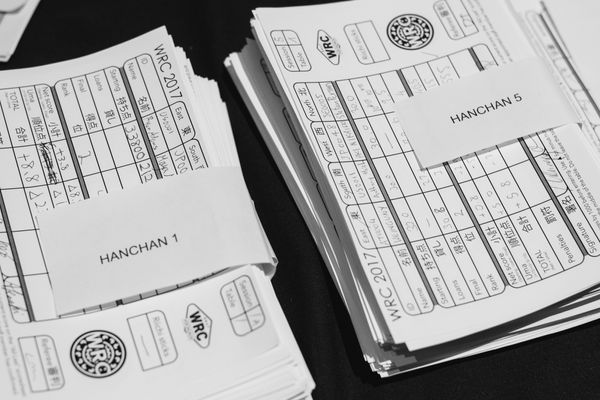Tile Efficiency 101 (Part 5) Climaxing

Be prepared to read.
You may have very well been able to understand the last pages in the original Japanese with the picture, but the following content is mainly theoric text, so unless you could understand it, you were missing on a lot.
I'm not back yet, but this post will do. I'm probably climaxing, myself, as of now if you know what I mean. Also, excuse my awkward Engrish.
If you don't understand what the heck this post is saying, then check here: http://www.osamuko.com/2010/10/29/tile-efficiency-101-part-2/
The text in brackets [ ] and sometimes in parenthesis ( ) are my translator notes.
Source: http://beginners.biz/h_07.html
How to select a discard
Simply selecting discards to move towards a complete hand shouldn't be that complicated. Advanced players can tell the most (tile-) efficient dicard at glance.How can they judge that in an instant? It is probably due to the next two reasons.
(1) Simplifying most hands into patterns, they understand what discard has the widest uke-ire.
Even starting hands that "won't come again," as they aim for the win, they distinguish patterns in the hand. Especially patterns that have a high occurrence rate, these must be remembered. If you doing the wrong choice, it will obviously show up in your logs.
(2) They have a superior method for comparing.
Virtually, it is unrealistic to count like "If I discard A then XX types XX tiles, if I discard B..." You should be able to keep your uke-ire at max without doing that.
I think that (1) and (2) are "The Essence of Tile Efficiency."
In mahjong tactics, there is a high focus on (1) and (2) is not really talked about all that much for some reason.
Ex1
![]()
![]()
![]()
![]()
![]()
![]()
![]()
![]()
![]()
![]()
![]()
![]()
![]() Tsumo:
Tsumo: ![]()
For example, with this hand you discard ![]() . The uke-ire to tenpai is the widest and since there is no difference in yaku, it is said to be absolutely right.
. The uke-ire to tenpai is the widest and since there is no difference in yaku, it is said to be absolutely right.
However, I think it is rare to find a case like example 1 in an actual game.
Ex2
![]()
![]()
![]()
![]()
![]()
![]()
![]()
![]()
![]()
![]()
![]()
![]()
![]() Tsumo:
Tsumo: ![]()
Since example 1 is presented in a lot of books on tactics, it is a normally aknowledged pattern.
However, saying "with three pairs you should always cut the middle tile," that is not so. In cases like example 2 with four pairs, whether you cut ![]()
![]()
![]()
![]() the uke-ire is the same. Killing the chance for iipeikou by discarding
the uke-ire is the same. Killing the chance for iipeikou by discarding ![]() cannot be considered a good discard.
cannot be considered a good discard.
I think that (2) is more important than (1). The patternification [...I know...] of tile efficiency is to:
"Diminish your misses and increase your discarding speed."
So I think.
There's a limit to everyone's memory for memorizing numbers of combinations. The ideal is to be able to deduce the best discard from every hand.
When approaching tile efficiency:
- 3 shanten or less [4 shanten, etc]
- 2 shanten
- 1 shanten
- tenpai
Why am I resuming 3 shanten or less in a single section? There are two reasons for that. When you are more than 3 away, it is hard enough to judge exactly how many away you are, and since most of the tiles may become unwanted tiles there is no reason to divide it into different cases.
1. Basic Tile Efficiency for 3 shanten or less
Regarding the hand at the beginning, discarding while thinking "if I discard this, what becomes a loss?" is good. There is no need to worry about decreasing the number of shanten.
There are delicate choices too, but there is no need thinking too deeply about things that don't make much of a difference. A little difference in probability is also important, but I think that leaving possibility for yaku and worrying about future defence is very important in most cases.
2. Basic Tile Efficiency for 2 shanten
It is also important to compare the uke-ire towards 1 shanten, but if there is only a difference of about 1 or 2 tiles, then it's better to select the way that will leave us with a wider uke-ire once we are 1 shanten.
The important nature in mahjong is said to be "The closer you are to tenpai, the more your uke-ire decreases."
The last barrier is 1 shanten > tenpai. If the uke-ire there is not good, then the way into tenpai becomes very difficult. That's why, even if we decrease the 2 shanten uke-ire just a little, we want to give more importance to the ease when we are 1 shanten.
(However, the view of "giving importance to the 2 shanten uke-ire" is also a very sound judgement)
Since in the case of 2 shanten there normally are a lot of patterns with isolated tiles, or overflowing taatsu (taatsu over/this is, you have more mentsu than you need) the judgement shouldn't be that hard.
3. Basic Tile Efficiency for 1 shanten
Having the widest uke-ire for tenpai becomes the top priority.
There rarely is place for a 1-2 tile difference here.
However, in cases where no matter what you do the uke-ire towards tenpai is narrow, it is also possible to decrease the uke-ire number and leave space for "evolution towards good shape." (ETGS)
In a case where there is no difference in the uke-ire number, it is pretty good do a comparison of ETGS.
4. Basic Tile Efficiency for Tenpai
Of course, the number of tiles is extremely important, but having a lot of winning tiles doesn't mean that winning off of someone else becomes easy.
If the tiles you are waiting on are an easy-go (deyasui, easy to be discarded/easy to come out), you can say it's an effective wait. This is to say, the likelyhood that a tile will come out is pretty hard to calculate in numbers. Basically, the first thing to do is look at the tile numbers.
If the number of tiles is the same, then it is important to compare the tiles that will improve the hand. Especially pair waits (tanki machi) are very easy to improve.
Above is the theory. Next time, we will look at concrete examples with the tile images [no, we probaby won't, it's way too large and there is other material to review].
This should be of much help. The original author of the text is a 鳳凰 player at tenhou, with a rate of over 2000, so yes he "knows what he's talking about." At least, if what you're aiming at is getting at 鳳凰/phoenix room (actually, it's not a phoenix? more like a houou...)
If you dare be brave, post in the comments what should the next post be about, or from where should it be translated. I'll take on chinese texts as well, so long as they are seemingly simple to understand and have enough pictures. w
Spanish, French, Portuguese and Italian are also welcomed (as if theory existed in those languages...).



